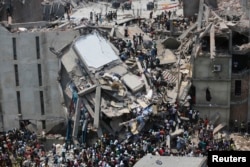Protests Sunday in Bangladesh are marking the third anniversary of the collapse of a garment factory building that killed more than 1,000 people.
The eight-story factory in a Dhaka suburb turned into a pile of rubble and twisted metal on April 24, 2013, killing and injuring workers.
No one has been convicted in connection with the disaster. Families of the dead workers and the surviving workers feel they have not been adequately compensated for their losses.
During the protests, union leader Abul Hossain said, "Three years have passed and still we do not see any justice. No one has been held to account for one of history's worst man-made disasters."
The Rana Plaza tragedy sparked international outrage and put pressure on European and U.S. clothing brands to improve pay and conditions at the factories that supply them.
Cracks appeared in the Rana Plaza building the day before the disaster. While a bank and a market housed in the complex decided to close, a number of the garment workshops ignored the danger.
More than 3,000 people were in the complex when it collapsed.
At the time of the collapse, wages in the $20 billion industry were as low as $37 a month for the four million workers, the majority of them women.
Some material for this report came from AFP and Reuters.










